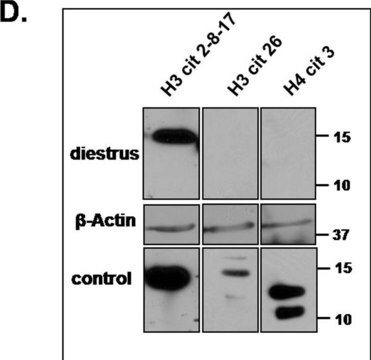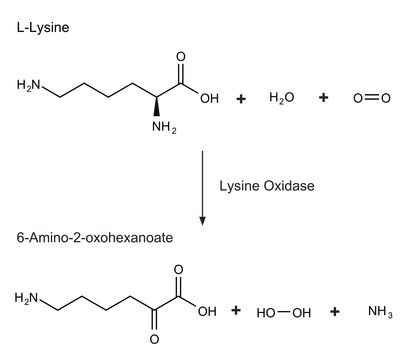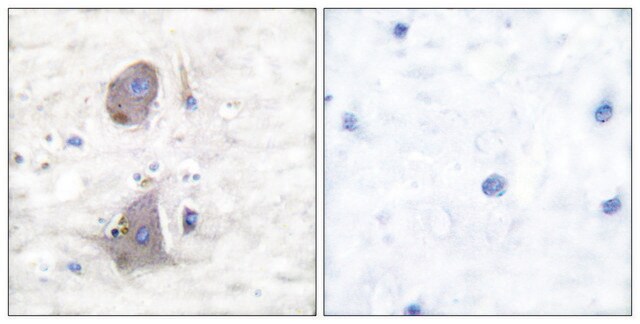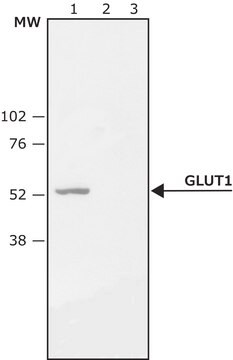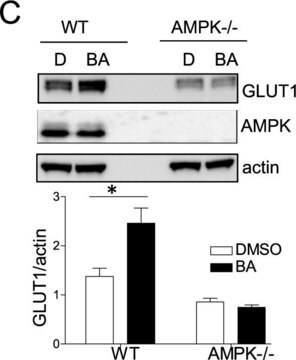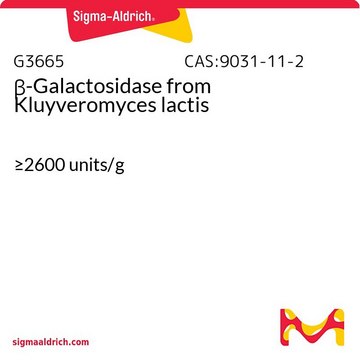ABN991
Anti-phospho GLUT-1 Antibody (Ser226)
from rabbit, purified by affinity chromatography
Sinonimo/i:
Solute carrier family 2, facilitated glucose transporter member 1, Glucose transporter type 1, erythrocyte/brain, GLUT-1, HepG2 glucose transporter, Human T-cell leukemia virus I and II receptor, Receptor for HTLV-1 and HTLV-2, phospho GLUT-1 (Ser226)
About This Item
Prodotti consigliati
Origine biologica
rabbit
Livello qualitativo
Forma dell’anticorpo
affinity isolated antibody
Tipo di anticorpo
primary antibodies
Clone
polyclonal
Purificato mediante
affinity chromatography
Reattività contro le specie
mouse, human
Reattività contro le specie (prevista in base all’omologia)
horse (based on 100% sequence homology), canine (based on 100% sequence homology), bovine (based on 100% sequence homology), Xenopus (based on 100% sequence homology), rat (based on 100% sequence homology), rabbit (based on 100% sequence homology)
tecniche
immunocytochemistry: suitable
inhibition assay: suitable (peptide)
western blot: suitable
N° accesso NCBI
N° accesso UniProt
Condizioni di spedizione
wet ice
modifica post-traduzionali bersaglio
phosphorylation (pSer226 )
Informazioni sul gene
human ... SLC2A1(6513)
Descrizione generale
Immunogeno
Applicazioni
Western Blotting Analysis: An 1:200 dilution (5 µg/mL) from a representative lot detected TPA-induced phosphorylation of wild-type GLUT-1, but not GLUT-1 with S226A mution in lysates from Rat2 fibroblasts expsssing the respective constructs via retrovirus-mediated transfection (Courtesy of Dr. Richard C. Wang, UT Southwestern Medical Center, Dallas, TX).
Western Blotting Analysis: An 1:200 dilution (5 µg/mL) from a representative lot detected a time-dependent GLUT-1 Ser226 phosphorylation induction in serum-starved human umbilical vein endothelial cells (HUVECs) and human aortic endothelial cells (HAECs) upon VEGF treatment (Courtesy of Dr. Richard C. Wang, UT Southwestern Medical Center, Dallas, TX).
Western Blotting Analysis: A representative lot detected PKC activation-induced GLUT-1 Ser226 phosphorylation in human aortic endothelial cells (HAECs) upon TPA (Cat. No. 500582 & 524400) treatment only the in the absence, but not in the presence, of PKC inhibitor Go 6983 (Cat. No. 365251) (Lee, E.E., et al. (2015). Mol. Cell. 58(5):845-853).
Western Blotting Analysis: A representative lot detected a time-dependent GLUT-1 Ser226 phosphorylation induction in serum-starved human umbilical vein endothelial cells (HUVECs) upon VEGF or angiotensin II treatment (Lee, E.E., et al. (2015). Mol. Cell. 58(5):845-853).
Western Blotting Analysis: A representative lot detected comparable Ser226 phosphorylation induction of exogenously expressed wild-type GLUT-1 or K526E mutant in transfected Rat2 fibroblasts upon PKC activator TPA (Cat. No. 500582 & 524400) treatment (Cat. No. 365251) (Lee, E.E., et al. (2015). Mol. Cell. 58(5):845-853).
Western Blotting Analysis: A representative lot detected PKC activator TPA-induced GLUT-1 Ser226 phosphorylation in serum-starved HeLa, human primary cardiac endothelial cells, EA.hy926 human endothelial cells, and bEnd.3 mouse brain endothelial cells (Lee, E.E., et al. (2015). Mol. Cell. 58(5):845-853).
Western Blotting Analysis: A representative lot detected PKC-catalyzed Ser226 phosphorylation of GST fusion protein containing wild-type GLUT-1 Loop 6 (4th cytoplasmic domain) seuqnce, but not GST-Loop 6 fusions with R223P, R223Q, R223W, or S226A mutation, in in vitro kinase assays (Lee, E.E., et al. (2015). Mol. Cell. 58(5):845-853).
Western Blotting Analysis: A representative lot detected a time-dependent GLUT-1 Ser226 phosphorylation induction in serum-starved human aortic endothelial cells (HAECs) upon VEGF treatment (Lee, E.E., et al. (2015). Mol. Cell. 58(5):845-853).
Immunocytochemistry Analysis: A representative lot detected PKC activation-induced GLUT-1 Ser226 phosphorylation in the membrane ruffles of human umbilical vein endothelial cells (HUVECs) upon TPA (Cat. No. 500582 & 524400) treatment (Lee, E.E., et al. (2015). Mol. Cell. 58(5):845-853).
Note: Process lysate samples by warming at 50°C for 10 minutes prior to gel loading. Avoid heating samples at a temperature higher than 60°C, which can cause aggregation of the target protein.
Qualità
Western Blotting Analysis: 2.0 µg/mL of this antibody detected Ser226 phosphorylated GLUT-1 in lysates from PMA-treated HeLa cells.
Descrizione del bersaglio
Altre note
Non trovi il prodotto giusto?
Prova il nostro Motore di ricerca dei prodotti.
Codice della classe di stoccaggio
12 - Non Combustible Liquids
Classe di pericolosità dell'acqua (WGK)
WGK 1
Punto d’infiammabilità (°F)
Not applicable
Punto d’infiammabilità (°C)
Not applicable
Certificati d'analisi (COA)
Cerca il Certificati d'analisi (COA) digitando il numero di lotto/batch corrispondente. I numeri di lotto o di batch sono stampati sull'etichetta dei prodotti dopo la parola ‘Lotto’ o ‘Batch’.
Possiedi già questo prodotto?
I documenti relativi ai prodotti acquistati recentemente sono disponibili nell’Archivio dei documenti.
Il team dei nostri ricercatori vanta grande esperienza in tutte le aree della ricerca quali Life Science, scienza dei materiali, sintesi chimica, cromatografia, discipline analitiche, ecc..
Contatta l'Assistenza Tecnica.